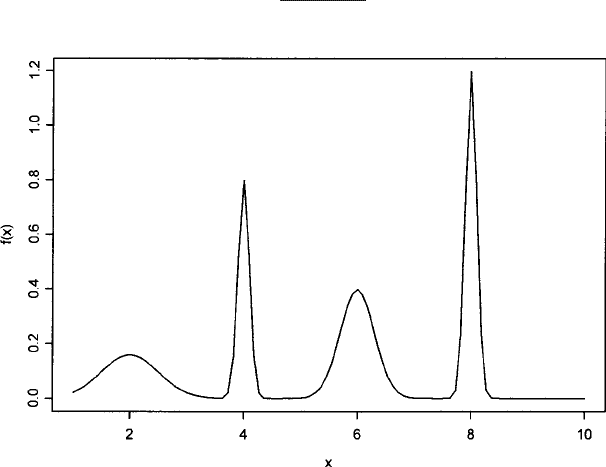Everitt B.S. The Cambridge Dictionary of Statistics
Подождите немного. Документ загружается.


exogeneity assumption is violated,
fixed-effects models
with fixed cluster-specificeffectsα
j
are sometimes preferred. Multilevel models are sometimes called mixed models because they
contain both fixed effects β
0
; β
1
; ...; β
q
and a random effects
0j
.
More complex linear multilevel models also include at least one random coefficient
1j
Y
ij
¼ β
0
þ β
1
x
1ij
þ β
2
x
2ij
þ ...þ β
q
x
qij
þ
0j
þ
1j
x
1ij
þ
ij
¼ðβ
0
þ
0j
Þþðβ
1
þ
1j
Þx
1ij
þ β
2
x
2ij
þ ...þ β
q
x
qij
þ
ij
where the effect of the covariate X
1ij
(which varies within clusters) vary between clusters
with random slope β þ
1j
. The random effects
0j
and
1j
have a bivariate normal distribu-
tion with zero means.
Multilevel generalized linear models or generalized linear mixed models are multilevel
models where random effects are introduced in the linear predictor of
generalized linear
models
. In addition to linear models for continuous responses, such models include, for
instance, logistic random effects models for dichotomous, ordinal and nominal responses
and log-linear random effects models for counts.
Multilevel models can also be specified for higher-level data where units are nested in
clusters which are nested in superclusters. An example of such a design would be measure-
ment occasions nested in subjects who are nested in communities. Other terms sometimes used
for multilevel models include mixed models. hierarchical models, random effects models and
random coeffiencnt models.[Multilevel Analysis, 1999, T. A. B. Snijders, Sage, London]
M ultimodal distribution: A probability distribution or frequency distribution with several modes.
Multimodality is often taken as an indication that the observed distribution results from the
mixing of the distributions of relatively distinct groups of observations. An example of a
distribution with four modes is shown in Fig. 96.
Multinomialcoefficient: The number of ways that k distinguishable items can be distributed into
n containers so that there are k
i
items in the ith container. Given by
k!
k
1
!k
2
! k
n
!
Fig. 96 A frequency distribution with four modes.
289

Multinomial distribution: A generalization of the
binomial distribution
to situations in which r
outcomes can occur on each of n trials, where r>2. Specifically the distribution is given by
Pðn
1
; n
2
; ...; n
r
Þ¼
n!
n
1
!n
2
! n
r
!
p
n
1
1
p
n
2
2
p
n
r
r
where n
i
is the number of trials with outcome i, and p
i
is the probability of outcome i
occurring on a particular trial. The expected value of n
i
is np
i
and its variance is np
i
ð1 p
i
Þ.
The covariance of n
i
and n
j
is np
i
p
j
. [STD Chapter 26.]
Multinomial logit model: See multinomial logistic regression.
Multinomial logistic regression: A form of
logistic regression
for use when the categorical
response variable has more than two unordered categories. If we let k be the number of
categories of the response variable, Y, then the model used (sometimes called the multi-
nomial logit model) is the following;
p
r
ðxÞ¼
expðx
0
β
r
Þ
P
k
s¼1
expðx
0
β
r
Þ
; r ¼ 1; ...; k
where p
r
ðxÞ¼PrðY ¼ r jxÞ; r ¼ 1; ...; k, x is a vector of explanatory variables and β
r
is a
vector of regression coefficients for category r. Because it is only possible to investigate the
effect of x upon the ‘preference’ of a response category compared to other categories, not all
the parameter vectors are identifiable so it is necessary to choose a reference category,
commonly category k and to take β
k
¼ 0. See also proportional odds model.[Applied
Logistic Regression, 2nd edn, 2000, D. W. Hosmer and S. Lemeshow, Wiley, New York.]
Multinormal distribution: Synonym for multivariate normal distribution.
Multiphasic screening: A process in which tests in
screening studies
may be performed in
combination. For example, in cancer screening, two or more anatomic sites may be screened
for cancer by tests applied to an individual during a single screening session. [American
Journal of Public Health, 1964, 54, 741–50.]
Mu lt ipl e compa r iso n tests: Procedures for detailed examination of the differences between a set
of means, usually after a general hypothesis that they are all equal has been rejected. No
single technique is best in all situations and a major distinction between techniques is how
they control the possible inflation of the type I error. See also Bonferroni correction,
Duncan’s multiple range test, Scheffé’s test and Dunnett’s test.[Biostatistics: A
Methodology for the Health Sciences , 2nd edition, 2004, G. Van Belle, L. D. Fisher,
P. J. Heagerty and T. S. Lumley, Wiley, New York.]
Multiplecorrelationcoefficient: The correlation between the observed values of the dependent
variable in a
multiple regression
, and the values predicted by the estimated regression
equation. Often used as an indicator of how useful the explanatory variables are in predicting
the response. The square of the multiple correlation coefficient gives the proportion of
variance of the response variable that is accounted for by the explanatory variables. [SMR
Chapter 12.]
Multipleendpoints: A term used to describe the variety of outcome measures used in many
clinical
trials
. Typically there are multiple ways to measure treatment success, for example, length of
patient survival, percentage of patients surviving for two years, or percentage of patients
experiencing tumour regression. The aim in using a variety of such measures is to gain better
overall knowledge of the differences between the treatments being compared. The danger
290
with such an approach is that the performance of multiple significance tests incurs an
increased risk of a
false positive result
. See also Bonferroni correction.[Statistics in
Medicine, 14, 1995, 1163–76.]
Multiple-frame surveys: Surveys that refer to two or more
sampling frames
that can cover a target
population. For example, in a study of AIDS a general population frame might be used in
addition to drug treatment centres and hospitals. Information from the samples is then
combined to estimate population quantities. Such surveys are very useful for sampling
rare or hard-to-reach populations and can result in considerable cost savings over a single
frame design with comparable precision. See also respondent-driven sampling and snow-
ball sampling.[Journal of the American Statistical Association, 2006, 10, 1019–1030.]
Multiple imputation: A
Monte Carlo method
in which
missing values
in a data set are replaced by
m>1 simulated versions, where m is typically small (say 3–10). Each of the simulated
complete datasets is analysed by the method appropriate to the investigation at hand, and the
results are later combined to produce estimates, confidence intervals etc. The imputations are
created by a Bayesian approach which requires specification of a parametric model for the
complete data and, if necessary, a model for the mechanism by which data become missing.
Also required is a
prior distribution
for the unknown model parameters.
Bayes’ theorem
is
used to simulate m independent samples form the conditional distribution of the missing
values given the observed values. In most cases special computation techniques such as
Markov chain Monte Carlo methods
will be needed. See also SOLAS.[The Analysis of
Incomplete Multivariate Data, 1997, J. Schafer, CRC/Chapman and Hall.]
Multiple indicator multiple cause model (MIMIC): A
structural equation model
in which
there are multiple indicators and multiple causes of each
latent variable
.[Modelling
Covariance and Latent Variables using EQS, 1993, G. Dunn, B. Everitt and A. Pickles,
Chapman and Hall/CRC Press, London.]
Multiple linear regression: Synonym for multiple regression.
Multiple regression: A term usually applied to models in which a continuous response variable, y,is
regressed on a number of explanatory variables, x
1
; x
2
; ...; x
q
. Explicitly the model fitted is
E ð yjx
1
; ...; x
q
Þ¼β
0
þ β
1
x
1
þþβ
q
x
q
where E denotes expected value. By introducing a vector y
0
¼½y
1
; y
2
; ...; y
n
and an
n ðq þ 1Þ matrix X given by
X ¼
1 x
11
x
12
x
1q
1 x
21
x
22
x
2q
.
.
.
.
.
.
.
.
.
.
.
.
.
.
.
1 x
n1
x
n2
x
nq
0
B
B
B
@
1
C
C
C
A
the model for n observations can be written as
y ¼ Xβ þ
where
0
¼½
1
;
2
; ...;
n
contains the residual error terms and β
0
¼½β
0
; β
1
; β
2
; ...; β
q
.
Least squares estimation
of the parameters involves the following set of equations
^
β ¼ðX
0
XÞ
1
X
0
y
The regression coefficients, β
1
; β
2
; ...; β
q
give the change in the response variable corre-
sponding to a unit change in the appropriate explanatory variable, conditional on the other
variables remaining constant. Significance tests of whether the coefficients take the value
291

zero can be derived on the assumption that for a given set of values of the explanatory
variables, y has a normal distribution with constant variance. See also regression diagnos-
tics, selection methods in regression and beta coefficient. [ARA Chapter 3.]
Multiple time response data: Data arising in studies of episodic illness, such as bladder cancer
and epileptic seizures. In the former, for example, individual patients may suffer multiple
bladder tumours at observed times, t
1
5
t
2
5
5
t
k
.
M ultiple time series: Observations taken simultaneously on two or more
time series
. Also known
as multivariate time series and vector time series. Environmental examples include readings
of lead concentrations at several sites at 5 minute intervals, air temperature readings taken at
hourly intervals at a fixed height above sea level at several locations and monthly ozone
levels at several recording stations. If the m series are represented as X
0
t
¼½x
1;t
; x
2;t
; ...; x
m;t
for t ¼ 1; 2; ...; n then the cross-covariance function, γ
ij
ðkÞis covðx
i;t
; x
j; tk
Þand the cross-
correlation function,
ij
ðkÞ is defined as
ij
ðkÞ¼
γ
ij
ðkÞ
½γ
ii
ð0Þγ
jj
ð0Þ
1
2
The matrix rðkÞ with ijth entry equal to
ij
ðkÞ can be used to define the spectral density
matrix, fðωÞ,defined as
fðωÞ¼
X
1
l¼1
expð2piωlÞrðkÞ0:5 ω 0:5
where i
2
¼1. The ijth element of this matrix is the cross-spectral density. The real and
imaginary parts of this matrix define the co-spectrum and quadrature spectrum. Multivariate
generalizations of
autoregressive moving average models
are available for modelling such a
collection of time series. See also coherence. [TMS Chapter 8.]
Multiplication rule for probabilities: For events A and B that are independent, the probability
that both occur is the product of the separate probabilities, i.e.
PrðA and BÞ¼PrðAÞ PrðBÞ
where Pr denotes probability. Can be extended to k independent events, B
1
; B
2
; ...; B
k
as
Prð\
k
i¼1
B
i
Þ¼
Y
k
i¼1
PrðB
i
Þ
[KA1 Chapter 8.]
Multiplicative intensity model: A generalization of the
Cox’s proportional hazards model
.[The
Annals of Statistics, 1978, 6, 701–26.]
Multiplicative model: A model in which the combined effect of a number of factors when applied
together is the product of their separate effects. See also additive model.
MULT ISCALE : Software for
multidimensional scaling
set in an inferential framework. [J. O. Ramsay,
Department of Psychology, McGill University, Steward Biological Sciences Building, 1205
Dr. Penfield Avenue, Montreal, QC, Canada H34 1B1.]
Mu lt istage sam pli ng: Synonym for cluster sampling.
Mu lt istate models: Models that arise in the context of the study of
survival times
. The experience
of a patient in such a study can be represented as a process that involves two (or more) states.
In the simplest situation at the point of entry to the study, the patient is in a state that
292

corresponds to being alive. Patients then transfer from this ‘live’ state to the ‘dead’ state at
some rate measured by the
hazard function
at a given time. More complex models will
involve more states. For example, a three-state model might have patients alive and tumour
free, patients alive and tumour present and the ‘dead’ state. See also Markov illness–death
model.[Statistics in Medicine, 1988, 7, 819–42.]
M u lt itaper spectra lesti mators: A very powerful class of procedures for estimating the
spectral
density
of a
time series
, which use the average of several direct spectral estimators. [Signal
Processing, 1997, 58, 327–32.]
Mu ltit rait^ mult imethod model ( MTMM ) : A form of
confirmatory factor analysis
model in
which different methods of measurement are used to measure each latent variable. Allows
the variance of each measure to be decomposed into trait variance, method variance and
measurement error variance. [Modelling Covariances and Latent Variables using EQS,
1993, G. Dunn, B. Everitt and A. Pickles, Chapman and Hall/CRC Press, London.]
Multivariate adaptive regression splines (MARS): A method of flexible
nonparametric
regression modelling
that works well with moderate sample sizes and with more than two
explanatory variables. [Journal of Computational and Graphical Statistics, 1997, 6,74–91.]
M ultivariate analysis: A generic term for the many methods of analysis important in investigating
multivariate data. Examples include
cluster analysis
,
principal components analysis
and
factor analysis
. [MV1 and MV2.]
Multivariate analysis of variance: A procedure for testing the equality of the mean vectors of
more than two populations for a multivariate response variable. The technique is directly
analogous to the
analysis of variance
of univariate data except that the groups are compared on
q response variables simultaneously. In the univariate case, F-tests are used to assess the
hypotheses of interest. In the multivariate case, however, no single test statistic can be
constructed that is optimal in all situations. The most widely used of the available test statistics
is Wilk’slambda(L) which is based on three matrices W (the within groups matrix of sums of
squares and products), T (the total matrix of sums of squares and cross-products)andB (the
between groups matrix of sums of squares and cross-products), defined as follows:
T ¼
X
g
i¼1
X
n
i
j¼1
ðx
ij
xÞðx
ij
xÞ
0
W ¼
X
g
i¼1
X
n
i
j¼1
ðx
ij
x
i
Þðx
ij
x
i
Þ
0
B ¼
X
g
i¼1
n
i
ð
x
i
xÞð
x
i
xÞ
0
where x
ij
; i ¼ 1; ...; g; j ¼ 1; ...; n
i
represent the jth multivariate observation in the ith
group, g is the number of groups and n
i
is the number of observations in the i th group. The
mean vector of the ith group is represented by
x
i
and the mean vector of all the observations
by
x. These matrices satisfy the equation
T ¼ W þB
Wilk’s lambda is given by the ratio of the determinants of W and T, i.e.
L ¼
jWj
jTj
¼
jWj
jW þ Bj
The statistic, L, can be transformed to give an F-test to assess the null hypothesis of the
equality of the population mean vectors. In addition to L a number of other test statistics are
available
293

*
Roy’s largest root criterion: the largest
eigenvalue
of BW
1
,
*
The Hotelling –Lawley trace: the sum of the eigenvalues of BW
1
,
*
The Pillai–Bartlett trace: the sum of the eigenvalues of BT
1
.
It has been found that the differences in power between the various test statistics are
generally quite small and so in most situations which one is chosen will not greatly affect
conclusions. [MV1 Chapter 6.]
Multivariate Bartlett test: A test for the equality of a number (k) of
variance-covariance
matrices
. The test statistic used is M given by
M ¼
jS
1
j
1
=2
jS
2
j
2
=2
...jS
k
j
k
=2
jSj
where
i
¼ n
i
1 where n
i
is the sample size of the ith sample, S
i
is the covariance matrix of
the ith sample, ¼
P
k
i¼1
i
and S is the pooled sample covariance matrix given by
S ¼
P
k
i¼1
i
S
i
P
k
i¼1
i
The statistic u ¼2ð1 c
1
Þlog M is under the null hypothesis of the equality of the
population covariance matrices, approximately distributed as chi-squared with
1
2
ðk 1Þpðp þ 1Þ degrees of freedom where p is the number of variables and
c
1
¼
X
k
i¼1
1
i
ð1=
X
k
i¼1
i
Þ
"#
2p
2
þ 3p 1
6ðp þ1Þðk 1Þ
[Encyclopedia of Statistical Sciences, 2006, eds. S. Kotz, C. B. Read, N. Balakrishnan and
B. Vidakovic, Wiley, New York.]
Mu lt i va r i at e Cauch y di str ibution: See Student’s t-distribution.
M ultivariate counting process: A
stochastic process
with k components counting the occur-
rences, as time passes, of k different types of events, none of which can occur simulta-
neously. [Statistical Analysis of Counting Processes, 1982, M. Jacobsen, Springer-Verlag,
New York.]
Multivariate data: Data for which each observation consists of values for more than one random
variable. For example, measurements on blood pressure, temperature and heart rate for a
number of subjects. Such data are usually displayed in the form of a data matrix, i.e.
X ¼
x
11
x
12
x
1q
x
21
x
22
x
2q
.
.
.
.
.
.
.
.
.
x
n1
x
n2
x
nq
0
B
B
B
@
1
C
C
C
A
where n is the number of subjects, q the number of variables and x
ij
the observation on
variable j for subject i. [MV1 Chapter 1.]
Multivariate distribution: The simultaneous probability distribution of a set of random variables.
See also multivariate normal distribution and Dirichlet distribution. [KA1 Chapter 15.]
M u ltivar iate growth data: Data arising in studies investigating the relationships in the growth of
several organs of an organism and how these relationships evolve. Such data enable
biologists to examine growth gradients within an organism and use these as an aid to
understanding its form, function and biological niche as well as the role of evolution in
bringing it to its present form. [Psychometrika, 2004, 69,65–79.]
294

Multivariate hypergeometric distribution: A probability distribution associated with
sam-
pling without replacement
from a population of finite size. The population consists of r
i
elements of type i, i ¼ 1; 2; ...; k with
P
k
i¼1
r
i
¼ N . Then the probability of finding x
I
elements of the ith type when a random sample of size n is drawn ðn ¼
P
x
i
Þ is
Prðx
1
; x
2
; ...; x
k
Þ¼
r
1
x
1
r
2
x
2
r
k
x
k
=
N
n
When k=2 this reduces to the
hypergeometric distribution
. The distribution is important in
conditional inference for 2 k
contingency tables
.[Statistical Analysis of Categorial Data,
1999, C. J. Lloyd, Wiley, New York.]
M ultivariate kurtosis measure: See Mardia’s multivariate normality test.
M ultivariate normal distribution: The probability distribution of a set of variables
x
0
¼½x
1
; x
2
; ...; x
q
given by
f ðx
1
; x
2
; ...; x
q
Þ¼ð2pÞ
q=2
jSj
1
2
exp
1
2
ðx mÞ
0
S
1
ðx mÞ
where m is the mean vector of the variables and S is their
variance–covariance matrix
. This
distribution is assumed by multivariate analysis procedures such as
multivariate analysis of
variance
. See also bivariate normal distribution. [KA1 Chapter 15.]
M ultivariate power exponential distribution: A multivariate probability distribution, f(x)
given by
f ðxÞ¼
nG
n
2
p
n
2
ffiffiffiffiffiffi
jSj
p
G 1 þ
n
2β
2
1þ
n
2β
exp
1
2
½ðx Þ0S
1
ðx Þ
β
The distribution has mean vector µ and
variance-covariance matrix
given by
2
1
β
G
nþ2
2β
nG
n
2β
S
When β ¼ 1; f ðxÞ becomes the
multivariate normal distribution
. In general f ðxÞ is an
elliptically contoured distribution in which β determines the
kurtosis
. For β
5
1 the distri-
bution has heavier tails than the normal distribution. [Nonlinear Models in Medical
Statistics, 2001, J. K. Lindsey, Oxford University Press, Oxford.]
M u lt iva riate prob it analysis: A method for assessing the effect of explanatory variables on a set
of two or more correlated binary response variables. See also probit analysis.[Biometrics,
1981, 37, 541–51.]
M u lt iva r iate skew -norma l d ist ri buti o n: See skew-normal distribution.
Multivariate Student’s t-distribution: See Student’s t-distribution.
M ultivariate time series: Synonym for multiple time series.
Mu lt i v a r i at e ZIP model ( M ZIP): A multivariate version of
zero-inflated Poisson regression
useful in monitoring manufacturing processes when several types of defect are possible.
[Technometrics, 1999, 41,29–38.]
Mutation distance: A distance measure for two amino acid sequences, defined as the minimal
number of nucleotides that would need to be altered in order for the gene of one sequence to
295
code for the other. [Branching Processes with Biological Applications, 1975, P. Jagers,
Wiley, New York.]
M utual ly exclusive events: Events that cannot occur jointly.
MYCIN: An
expert system
developed at Stanford University to assist physicians in the diagnosis and
treatment of infectious diseases. The system was never used in practice, not because of any
weakness in performance, but because of ethical and legal problems related to the use of
computers in medicine – if it gives the wrong diagnosis who would you sue? [Rule-Based
Expert Systems, 1985, B. G. Buchanan and E. H. Shortliffe, Addison-Wesley, Reading,
MA.]
MZIP: Abbreviation for multivariate ZIP model.
296

N
N ada raya- Watson esti mat or: An estimator used to estimate regression functions based on data
x
i
; y
i
fg
. The estimator produces an estimate of Y at any requested value of X (not only the
ones in the data). A
kernel function
is used to assign weights to be put on values in the data
near X in estimating Y.[Nonparametric Functional Data Analysis: Theory and Practice,
2006, F. F. Erraty and P. V. Ieu, Springer, New York.]
NAG: Numerical Algorithms Group producing many useful subroutines relevant to statistics. [NAG
Ltd., Wilkinson House, Jordan Hill Road, Oxford, OX2 8DR; NAG Inc., 1431 Opus Place,
Suite 220, Downers Grove, Illinois 60515-1362, USA; www.nag.co.uk]
Naor’s distribution: A discrete probability distribution that arises from the following model;
Suppose an urn contains n balls of which one is red and the remainder are white.
Sampling with replacement of a white ball (if drawn) by a red ball continues until a
red ball is drawn. Then the probability distribution of the required number of draws,
Y,is
PrðY ¼ yÞ¼
ðn 1Þ!y
ðn yÞ!n
y
After n − 1 draws the urn contains only red balls and so no more than n draws are required.
[Univariate Discrete Distributions, 2005, N. L. Johnson, A. W. Kemp and S. Kotz, Wiley,
New York.]
National lotteries: Games of chance held to raise money for particular causes. The first held in the
UK took place in 1569 principally to raise money for the repair of the Cinque Ports. There
were 400 000 tickets or lots, with prizes in the form of plate, tapestries and money.
Nowadays lotteries are held in many countries with proceeds either used to augment the
exchequer or to fund good causes. The current UK version began in November 1994 and
consists of selecting six numbers from 49 for a one pound stake. The winning numbers are
drawn ‘at random’ using one of a number of ‘balls-in-drum’ type of machine. [Chance
Rules, 2nd edn, 2008, B. S. Everitt, Springer-Verlag, New York.]
Natural-pairing: See paired samples.
N earest-nei ghbour cl ust eri ng: Synonym for single linkage clustering.
N earest-nei ghbour methods I: Methods of
discriminant analysis
based on studying the
training
set
subjects most similar to the subject to be classified. Classification might then be decided
according to a simple majority verdict among those most similar or ‘nearest’ training set
subjects, i.e. a subject would be assigned to the group to which the majority of the
‘neighbours’ belonged. Simple nearest-neighbour methods just consider the most similar
neighbour. More general methods consider the k nearest neighbours, where k>1.
[Discrimination and Classification, 1981, D. J. Hand, Wiley, Chichester.]
297

Nearest -neig hbour methods II: Methods used in the preliminary investigation of
spatial data
to
assess depatures from
complete spatial randomness
. For example, histograms of distances
between nearest neighbours are often useful. [Spatial Processes: Models and Applications,
1981, A. D. Cliff and K. Ord, Penn, London.]
Necessarily empty cells: Synonym for structural zeros.
Negative binomial distribution: The probability distribution of the number of failures, X, before
the kth success in a sequence of
Bernoulli trials
where the probability of success at each trial
is p and the probability of failure is q =1−p. The distribution is given by
PrðX ¼ xÞ¼
k þ x 1
x
p
k
q
x
0 x
5
1
The mean, variance,
skewness
and
kurtosis
of the distribution are as follows:
mean ¼ kq=p
variance ¼ kq=p
2
skewness ¼ð1 þ qÞðkqÞ
1
2
kurtosis ¼ 3 þð1 þ4p þ p
2
Þ=ðkpÞ
Often used to model
overdispersion
in count data. [STD Chapter 28.]
Negative exponential distr ibution: Synonym for exponential distribution.
Negative hypergeometric distribution: In
sampling without replacement
from a population
consisting of r elements of one kind and N − r of another, if two elements corresponding to
that selected are replaced each time, then the probability of finding x elements of the first
kind in a random sample of n elements is given by
PrðxÞ¼
r þ x 1
x
N r þ n x 1
n x
N þn 1
n
The mean of the distribution is Nr/N and the variance is (nr/N)(1−r/N)(N+n)/(N+1).
Corresponds to a
beta binomial distribution
with integral parameter values. [KA1
Chapter 5.]
N egat ive mult i no m i na l distr i buti on: A generalization of the
negative binomial distribution
in
which r > 2 outcomes are possible on each trial and sampling is continued until m outcomes
of a particular type are obtained. [Biometrika, 1949, 36,47–58.]
Negative predictive val ue: The probability that a person having a negative result on a
diagnostic
test
does not have the disease. See also positive predictive value. [SMR Chapter 14.]
Negative skewness: See skewness.
Negative study: A study that does not yield a statistically signifi cant result.
Negative synergism: See synergism.
N ei gh bourh ood cont ro ls: Synonym for community controls.
Ne lder ^ M ead si mplex algo rithm: Type of simplex algorithm.
Nelson ^ Aalen estimator: A nonparametric estimator of the
cumulative hazard function
from
censored
survival data
. Essentially a
method of moments
estimator. [Biometrics , 1996, 52,
1034–41.]
298
